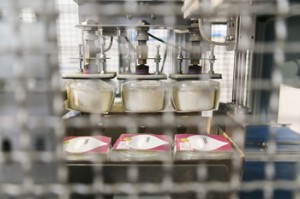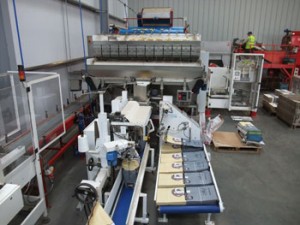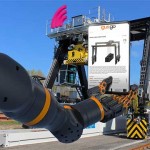Why it pays UK food manufacturers to automate
 Food and drink manufacturers are this week backing calls to boost UK food production following reports that the nation’s self sufficiency is on the slide and within a generation over half of the UK’s food will be imported. Dennis Allison (pictured right), managing director of Pacepacker Services, explains why it pays UK food producers to automate.
Food and drink manufacturers are this week backing calls to boost UK food production following reports that the nation’s self sufficiency is on the slide and within a generation over half of the UK’s food will be imported. Dennis Allison (pictured right), managing director of Pacepacker Services, explains why it pays UK food producers to automate.
The National Farming Union (NFU) has announced that Britain’s production of home grown food is expected to fall to just 53% by 2040 – a drop of almost 40% since the 1980′s. This research is leading to growing demand for government investment to increase productivity and the efficiency of UK food producers.
The situation is also exacerbated by the supermarket price wars and global brands competing for shelf space, with many UK food suppliers caught in the middle and seeing their profit margins squeezed. In 2014, around 150 food producers entered insolvency. For many, these price squeezes may have been the tipping point. What’s more, this figure, doesn’t take into account the number of UK sole traders or simple partnerships that may have folded.
UK manufacturers are waking up to the cost and service benefit of investing in automation. As testament, 75% of all enquiries Pacepacker received in the last 12 months requested a robotic solution, compared to 35% in 2013
Following the Christmas trading announcements in January, Sainsbury’s revealed that it would be cutting prices on 1,000 popular products. Asda unveiled similar plans, saying it will invest £300m into price cuts in quarter 1 of 2015 and the general consensus is most food retailers will follow suit.
While margins are squeezed tighter this will undoubtedly impact buying practices and consequently food suppliers. However the fall in homegrown food is in stark contrast to the increasing demand for local produce from the UK population. According to the NFU commissioned poll, 85% of the UK population said they wanted more British food in the supermarket. It also revealed that people believe the British government should do more to ensure a secure and affordable supply of British food.
 There is little doubt that government funding to strengthen R&D, particularly within agricultural producers, will help UK food producers become more competitive. It will also open up new export market possibilities for our home-grown produce, whilst also meeting growing local demands on UK shores.
There is little doubt that government funding to strengthen R&D, particularly within agricultural producers, will help UK food producers become more competitive. It will also open up new export market possibilities for our home-grown produce, whilst also meeting growing local demands on UK shores.
Investment in cutting edge technology, such as automated packing plants is needed to help food producers and contract packers avoid falling behind overseas competitors, missing critical business opportunities or losing industry influence. Aside from driving costs down, automating manufacturing processes improves quality, reduces waste and optimises energy use. In a relatively high cost economy, like the UK, automation will consequently increase a manufacturer’s competitive edge.
While manufacturing processes in the UK food industry are fairly well automated (palletising for example is approximately 60% automated) the more labour-intensive packing element at 10% is not. As a nation, we lag way behind our European neighbours, as well as Asia and emerging markets. My view, shared by many industry colleagues, is some countries are just more comfortable with automation. Take Germany as an example; for every one robot sold in the UK, it’s estimated that 10 are sold in Germany.
However, an increasing number of UK manufacturers are waking up to the cost and service benefit of investing in automation. As testament, 75% of all enquiries Pacepacker received in the last 12 months requested a robotic solution, compared to 35% in 2013.
The more efficient a business is, the more opportunities this presents. Even with the price squeezes, automation can enhance product quality and increase throughput. What’s more, a well thought out turnkey line or robotics solution can start paying its own way in as little as 12 months.
Flexible equipment that’s easily reconfigured
An emerging requirement is for multi-functional and flexible equipment that can easily be reconfigured. This is driven by ever-changing consumer tastes and pack variations. There’s a definite shift from single use systems built for a specific application to perform a set task, to robotics, which can easily be reprogrammed and redeployed to do a different job.
 Naturally, the impending election creates some uncertainly. Some believe investment in UK manufacturing may stall. I do hope not. Last year was a real turning point, evidenced by the recent EEF/Aldermore research report.** Our UK economy expanded at a good pace through 2014 and manufacturing grew by 3.5%, its strongest growth rate since 2010. This survey suggests that growth in 2015 will be at a more moderate pace, more likely through efficiency improvements, leading to lower costs.
Naturally, the impending election creates some uncertainly. Some believe investment in UK manufacturing may stall. I do hope not. Last year was a real turning point, evidenced by the recent EEF/Aldermore research report.** Our UK economy expanded at a good pace through 2014 and manufacturing grew by 3.5%, its strongest growth rate since 2010. This survey suggests that growth in 2015 will be at a more moderate pace, more likely through efficiency improvements, leading to lower costs.
Another worry for many is finances and being exposed to fluctuating exchange rates. Even if you aren’t trading internationally, the value of the pound can affect the cost of imports. In times like these, partnering, where possible, with local suppliers of components is just one way that we can better control quality and costs, which can be passed onto customers. An ethos we share at Pacepacker.
One thing is for sure, investment in UK automation will continue to play a huge part in making production facilities more efficient. However, help and funding is needed to help smaller food producers prosper and ultimately help pave the way for a stronger UK food sector that will enable us to grab a larger share of the export market too. The big question is not “can I afford to automate?” but “can I afford not to?”
Visit the Pacepacker Services website for more information.
See all stories for Pacepacker Services















